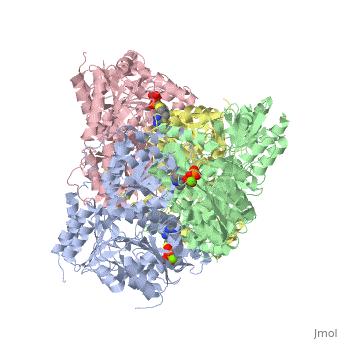1ovm
From Proteopedia
Crystal structure of Indolepyruvate decarboxylase from Enterobacter cloacae
Structural highlights
FunctionEvolutionary ConservationCheck, as determined by ConSurfDB. You may read the explanation of the method and the full data available from ConSurf. Publication Abstract from PubMedThe thiamin diphosphate-dependent enzyme indolepyruvate decarboxylase catalyses the formation of indoleacetaldehyde from indolepyruvate, one step in the indolepyruvate pathway of biosynthesis of the plant hormone indole-3-acetic acid. The crystal structure of this enzyme from Enterobacter cloacae has been determined at 2.65 A resolution and refined to a crystallographic R-factor of 20.5% (Rfree 23.6%). The subunit of indolepyruvate decarboxylase contains three domains of open alpha/beta topology, which are similar in structure to that of pyruvate decarboxylase. The tetramer has pseudo 222 symmetry and can be described as a dimer of dimers. It resembles the tetramer of pyruvate decarboxylase from Zymomonas mobilis, but with a relative difference of 20 degrees in the angle between the two dimers. Active site residues are highly conserved in indolepyruvate/pyruvate decarboxylase, suggesting that the interactions with the cofactor thiamin diphosphate and the catalytic mechanisms are very similar. The substrate binding site in indolepyruvate decarboxylase contains a large hydrophobic pocket which can accommodate the bulky indole moiety of the substrate. In pyruvate decarboxylases this pocket is smaller in size and allows discrimination of larger vs. smaller substrates. In most pyruvate decarboxylases, restriction of cavity size is due to replacement of residues at three positions by large, hydrophobic amino acids such as tyrosine or tryptophan. Crystal structure of thiamindiphosphate-dependent indolepyruvate decarboxylase from Enterobacter cloacae, an enzyme involved in the biosynthesis of the plant hormone indole-3-acetic acid.,Schutz A, Sandalova T, Ricagno S, Hubner G, Konig S, Schneider G Eur J Biochem. 2003 May;270(10):2312-21. PMID:12752451[1] From MEDLINE®/PubMed®, a database of the U.S. National Library of Medicine. See AlsoReferences
| ||||||||||||||||||||


